.png.webp) | |
| Agency overview | |
|---|---|
| Formed | 1937 |
| Jurisdiction | City of Chicago |
| Headquarters | 60 E. Van Buren Street Chicago, Illinois, U.S. |
| Annual budget | $976 million (2015)[1][2] |
| Agency executive |
|
| Website | thecha |
| Part of a series on |
| Living spaces |
|---|
 |
The Chicago Housing Authority (CHA) is a municipal corporation that oversees public housing within the city of Chicago. The agency's Board of Commissioners is appointed by the city's mayor, and has a budget independent from that of the city of Chicago. CHA is the largest rental landlord in Chicago, with more than 50,000 households. CHA owns over 21,000 apartments (9,200 units reserved for seniors and over 11,400 units in family and other housing types). It also oversees the administration of 37,000 Section 8 vouchers. The current acting CEO of the Chicago Housing Authority is Tracey Scott.
History
The CHA was created in 1937 to own and operate housing built by the federal government's Public Works Administration. In addition to providing affordable housing for low-income families and combating blight, it also provided housing for industry workers during World War II and returning veterans after the war. By 1960, it was the largest landlord in Chicago. In 1965, a group of residents sued the CHA for racial discrimination. After the landmark court decision Gautreaux v. Chicago Housing Authority (see below), the CHA was placed in receivership, which would last for more than 20 years. Things continued to deteriorate for the agency and its residents, and by the 1980s, the high concentrations of poverty and neglected infrastructure were severe.
The Chicago Housing Authority Police Department was created in 1989 to provide dedicated policing for what had become one of the most impoverished and crime-ridden housing developments in the country, and was dissolved only ten years later. The situation was so dire that the entire CHA board of commissioners resigned in 1995, effectively handing over control of the agency to Housing and Urban Development. After an extensive overhaul, management of the CHA was returned to a new board of commissioners, including three residents appointed by resident groups, in 1999. The previously ordered receivership ended in 2010.[3][4][5][6]
Chief Executive Officers (1937–present)
| Name | Term | Appointed by | Cite |
|---|---|---|---|
| Elizabeth Wood | 1937 – 23 August 1954 | Edward Kelly | |
| William B. Kean | 1 October 1954[7] – 14 August 1957 | Edward Kelly | |
| Alvin E. Rose[7] | 1 September 1957 – 26 November 1967[8] | Richard J. Daley | |
| Clement Humphrey[9] | 2 December 1967 – 1 July 1973 | Richard J. Daley | |
| Harry J. Schneider[10] | 1 July 1973 – 1975 | Richard J. Daley | |
| G. W. Master | August 1975 – April, 1976 (acting)[7] May 1976 – 1 October 1979 | Richard J. Daley | |
| Charles R. Swibel[7] | 15 October 1979 – June 1981 | Jane Byrne | |
| Andrew Mooney | June 1981[7] – 26 July 1982 (acting) 1 August 1982 – 1 May 1983 | Jane Byrne | |
| Zirl N. Smith | 30 May 1983 – 7 January 1987[11] | Harold Washington | |
| Brenda J. Gaines | 7 January 1987 – 6 May 1988 (acting) | Harold Washington | |
| Vincent Lane[12] | 6 May 1988[13] – 30 May 1995 | Eugene Sawyer | |
| Joseph Shuldiner[14] | 30 May 1995[15] – September 1995 (acting) 16 October 1995[16] – 1 June 1999 | HUD | |
| Terry Peterson | 1 June 1999 – 30 August 2006[17] | Richard M. Daley | |
| Sharon Gist-Gilliam | 31 August 2006 – 16 January 2008 (acting) | Richard M. Daley | |
| Lewis Jordan[18] | 16 January 2008 – 30 June 2011[19] | Richard M. Daley | |
| Charles Woodyard | 24 October 2011 – 15 October 2013[20][21] | Rahm Emanuel | |
| Michael Merchant | 16 October 2013 – 5 June 2015 | Rahm Emanuel | |
| Eugene Jones | 8 June 2015 – 10 September 2019 (acting CEO 8 June 2015 — 6 February 2016) | Rahm Emanuel | [22][23][24][25] |
| James L. Bebley | 17 September 2019 – 30 March 2020 (acting) | — | [25][26] |
| Tracey Scott | 30 March 2020 – present | Lori Lightfoot | [27][25][28] |
Redevelopment
Plan for Transformation (2000)
In 2000, the CHA began its Plan For Transformation, which called for the demolition of all of its gallery high-rise buildings and proposed a renovated housing portfolio totaling 25,000 units. The Plan for Transformation has also been plagued with problems. While demolition began almost immediately, CHA was slow to develop mixed-income units or provide Section 8 vouchers as planned.
Plan Forward (2013)
In April 2013, CHA created Plan Forward, the next phase of redeveloping public housing in Chicago. The plan includes the rehabilitation of other scattered-site, senior, and lower-density properties; construction of mixed-income housing; increasing economic sales around CHA developments; and providing educational and job training to residents with Section 8 vouchers.[3][29]
In 2015, the Secretary of Housing and Urban Development criticized the Chicago Housing Authority for accumulating a cash reserve of $440 million at a time when more than a quarter million people were on the agency's waiting list for affordable housing,[30] and a large number of units (16%) remained vacant.[31][32][33] By March 2017, only 8% of the 17,000 demolished households had been replaced with mixed-income units.[34] Many lots remain vacant decades after demolition, and the CHA has been selling, leasing, or trading land in gentrifying neighborhoods to other government agencies and the private sector for less than market value. Land owned by the CHA has been used to build two Target stores, a private tennis complex, and government facilities at a time when over 30,000 people are awaiting housing assistance from the CHA.[35] One notable resident, Chicago alderwoman Jeanette Taylor, revealed that she applied for housing assistance as a single mother in 1993 and received an approval letter almost thirty years later in May 2022.[36] More than 20 years after the initial plan was announced, then-Chicago mayor Lori Lightfoot announced in June 2021 that finishing the redevelopment of Cabrini-Green alone will take at least another 12 years and could total upwards of $1 billion.[37]
Demographics
From its beginning until the late-1950s, most families that lived in Chicago housing projects were Italian immigrants. By the mid-1970s, 65% of the agency's housing projects were made up of African Americans. In 1975, a study showed that traditional mother and father families in CHA housing projects were almost non-existent and 93% of the households were headed by single females. In 2010, the head of households demographics were 88% African American and 12% White.[38] The population of children in CHA decreased from 50% in 2000 to 35% by 2010. Today on average, a Chicago public housing development is made up of: 69% African-American, 27% Latino, and 4% White and Other.[39]
Lawsuits
Gautreaux v. Chicago Housing Authority
In 1966, Dorothy Gautreaux and other CHA residents brought a suit against the CHA in Gautreaux v. Chicago Housing Authority. The suit charged racial discrimination by the housing authority for concentrating 10,000 public housing units in isolated Black neighborhoods. It claimed that the CHA and Housing and Urban Development (HUD) had violated the U.S. Constitution and the 1964 Civil Rights Act. It was a long-running case that in 1987 resulted in HUD taking over the CHA for over 20 years and the formation of the Gautreaux Project in which public housing families were relocated to the suburbs. The lawsuit was noted as the nation's first major public housing desegregation lawsuit.[40]
Other lawsuits
In May 2013, The Cabrini–Green Local Advisory Council and former residents of the Cabrini–Green Homes sued the housing authority for reneging on promises for the residents to return the neighborhood after redevelopment. The suit claimed that the housing authority at the time had only renovated a quarter of the remaining row-houses, making only a small percentage of them public housing.[41]
In September 2015, four residents sued the housing authority over utility allowances. Residents claimed the CHA overcharged them for rent and didn't credit them for utility costs.[42]
In June 2023, Several groups including the Chicago Housing Initiative and the Lugenia Burns Hope Center sued CHA of illegally planning to lease public housing land at the former ABLA Homes to Joe Mansueto, one of then-Chicago Mayor Lori Lightfoot's campaign donors to build a training complex for his professional soccer team Chicago Fire.[43][44]
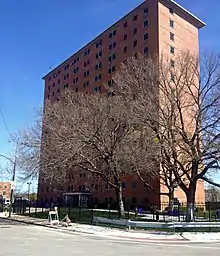
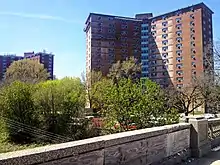
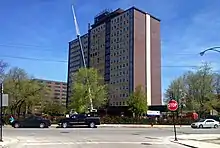
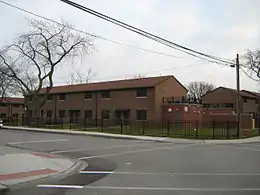
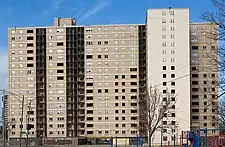
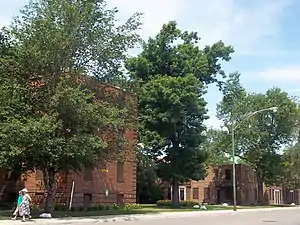

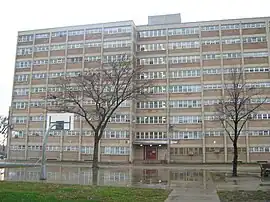
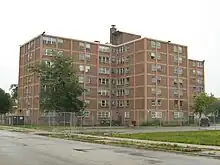
Developments
Housing projects
| Name | Neighborhood | Constructed | Notes/status |
|---|---|---|---|
| Altgeld Gardens Homes | Riverdale (Far South Side) | 1944–46; 1954 | Named for Illinois politician John Peter Altgeld and Labor movement leader Philip Murray. 1,971 units of 2-story row houses; renovated. |
| Bridgeport Homes | Bridgeport (Southwest Side) | 1943–44 | Named after its neighborhood location, consist of 115 units of 2-story row houses, renovated. |
| Cabrini–Green Homes | Near North Side | 1942–45; 1957–62 | Named for Italian nun Frances Cabrini and William Green. Consisted of 3,607 units, William Homes and Cabrini Extensions (demolished; 1995–2011), Francis Cabrini row houses (150 of 586 renovated; 2009–11). |
| Clarence Darrow Homes | Bronzeville (South Side) | 1961–62 | Named for American lawyer Clarence Darrow, consisted of 4 18-story buildings, demolished in late 1998. Replaced with Oakwood Shores, a mixed-income housing development.[45] |
| Dearborn Homes | Bronzeville (South Side) | 1949–50 | Named for its location on Dearborn Street; consists of 12 buildings made up of mid-rise, 6 and 9-stories, totaling 668 units, renovated. |
| Grace Abbott Homes | University Village (Near West Side) | 1952–55 | Named for social worker Grace Abbott, consisted of 7 15-story buildings and 33 2-story row houses, totaling 1,198 units. Demolished. |
| Harold Ickes Homes | Bronzeville (South Side) | 1953–55 | Named for Illinois politician Harold L. Ickes; 11 9-story high-rise buildings, totaling 738 units; demolished. |
| Harrison Courts | East Garfield Park (West Side) | 1958 | Named after its street location; consists of 4 7-story buildings; renovated. |
| Ogden Courts | North Lawndale (West Side) | 1953 | Named after William B. Ogden; consisted of 2 7-story buildings; demolished. |
| Henry Horner Homes | Near West Side | 1955–57; 1959–61 | Named for Illinois governor Henry Horner, consisted of 16 high-rise buildings, 2 15-story buildings, 8 7-story buildings, 4 14-story and 2 8-story buildings, totaling 1,655 units; demolished. Replaced with West Haven, a mixed-income housing development. |
| Ida B. Wells Homes | Bronzeville (South Side) | 1939–41 | Named for African-American journalist Ida B. Wells, consisted of 1,662 units (800 row houses and 862 mid-rise apartments); demolished. Replaced with Oakwood Shores, a mixed-income housing development.[45] |
| Jane Addams Homes | University Village (Near West Side) | 1938–39 | Named for social worker Jane Addams, consisted of 32 buildings of 2, 3, and 4 stories, totaling 987 units; demolished. Replaced with townhouses and condominiums under the name Roosevelt Square. |
| Julia C. Lathrop Homes | North Center (North Side) | 1937–38 | Named for social reformer Julia Lathrop, consists of 925 units made up of 2-story row houses, mid-rise buildings; renovated. |
| Lake Parc Place/ | Oakland (South Side) | 1962–63 | Named after its location, consisted of 6 buildings; Lake Michigan high-rises (also known as Lakefront Homes; 4 16-story buildings; vacated in 1985 and demolished by implosion on 12/12/1998)[47][48] and Lake Parc Place (2 15-story buildings; renovated) |
| Lawndale Gardens | Little Village (Southwest Side) | April–December 1942 | Named for its street location, consists of 123 units of 2-story row houses, renovated. |
| LeClaire Courts | Archer Heights (Southwest Side) | 1949–50; 1953–54[49] | Consisted of 314 units of 2-story row houses;[50] demolished. |
| Loomis Courts | University Village (Near West Side) | 1951 | Named for its street location, consists of 2 7-story buildings, totaling 126 units. |
| Lowden Homes | Princeton Park (South Side) | 1951–52 | Named for Illinois governor Frank Lowden, consist of 127 units of 2-story row houses; renovated. |
| Madden Park Homes | Bronzeville (South Side) | 1968–69; 1970 | Consisted of 6 buildings (9 and 3 stories), totaling 279 units; demolished. Replaced with Oakwood Shores, a mixed-income housing development.[45] |
| Prairie Courts | South Commons (South Side) | 1950–52 | Consisted of 5 7- and 14-story buildings, 230 units made up of row houses, totaling 877 units; demolished. Replaced with new development which was constructed between 2000–2002. |
| Racine Courts | Washington Heights (Far South Side) | 1953 | Named for its street location, Consisted of 122 units made up of 2-story row-houses.[51] Demolished. |
| Raymond Hilliard Homes | Near South Side | 1964–66 | Consists of 3 buildings, 22-story building; 16-story building and 11-story building, totaling 1,077 units. Renovated in phases, Phase I: 2003–04; Phase II: 2006–07. |
| Robert Brooks Homes/ | University Village (Near West Side) | 1942–43; 1960–61 | Consist of 835 row-houses (Reconstructed in phases: Phase I: 1997–99, Phase II: 2000), 3 16-story buildings (450 units; demolished between 1998–2001). |
| Robert Taylor Homes | Bronzeville (South Side) | 1960–62 | Named for the first African American chairman of the Chicago Housing Authority Robert Rochon Taylor, consisted of 28 16–story high rises, totaling 4, 415 units; demolished between 1998–2007. Replaced with Legends South, a mixed-income housing development.[52] |
| Rockwell Gardens | East Garfield Park (West Side) | 1958–60 | Named for its street location; consisted of 1,126 units made up of 11 buildings (16- and 14-story); demolished between 2003–2007. Replaced with West End, a mixed-income housing development. |
| Stateway Gardens | Bronzeville (South Side) | 1955–58 | Named for its location along State Street, consisted of 8 buildings (13–17 stories); demolished between 1996–2007, replaced with Park Boulevard, a mixed-income housing development. |
| Trumbull Park Homes | South Deering (Far South Side) | 1938–39 | Consists of 434 units made up of 2-story row houses and 3-story buildings; renovated. |
| Wentworth Gardens | Armour Square (South Side) | 1944–45 | Named for its street location and the major league baseball team that used to play at its baseball field. Stretching from 39th & Wentworth to 37th and Wells. Consists of a 4 block area of 2-story row-houses, 3 mid-rise buildings; renovated. |
| Washington Park Homes | Bronzeville (South Side) | 1962–64 | Named for nearby Chicago Park District park and neighborhood, consisted of 5 17-story buildings located between 45th and 44th Streets, Cottage Grove Avenue and Evans Street; demolished between 1999 and mid-2002. |
Other housing
In addition to the traditional housing projects, CHA has 51 senior housing developments,[53] 61 scattered site housing[54] and 15 mixed-income housing developments.[55]
Notable residents
- R. Kelly – Ida B. Wells Homes
- Mr. T – Robert Taylor Homes
- Maurice Cheeks – Robert Taylor Homes
- Curtis Mayfield – Cabrini–Green Homes
- Eric Monte – Cabrini–Green Homes
- Jerry Butler – Cabrini–Green Homes
- Kirby Puckett – Robert Taylor Homes
- Deval Patrick – Robert Taylor Homes
- Marvin Smith – Robert Taylor Homes
- Lou Rawls – Ida B. Wells Homes
See also
- Hills v. Gautreaux, a 1976 Supreme Court case
- Chicago Housing Authority Police Department
- Marshall Field Garden Apartments
References
- ↑ "CHA - FINANCIAL REPORTS". Archived from the original on 2016-06-30. Retrieved 2016-06-16.
- ↑ Chicago Housing Authority passes 2012 budget
- 1 2 "About | The Chicago Housing Authority". www.thecha.org. Retrieved 2020-07-03.
- ↑ "Judge ends CHA receivership". Crain's Chicago Business. 2010-05-20. Retrieved 2020-07-04.
- ↑ Terry, Don (1995-05-28). "Chicago Housing Agency To Be Taken Over by U.S." The New York Times. ISSN 0362-4331. Retrieved 2021-09-29.
- ↑ "AGREEMENT WITH HUD RETURNS CHICAGO HOUSING AUTHORITY TO LOCAL CONTROL". HUD Archives. 27 May 1999. Retrieved 29 September 2021.
- 1 2 3 4 5 "Chicago Tribune - Historical Newspapers". Chicago Tribune. Retrieved 2021-02-15.
- ↑ "Gautreaux v. Chicago Housing Authority, 296 F. Supp. 907 – CourtListener.com". CourtListener. Retrieved 2021-02-15.
- ↑ Lorenz, Rich. "EX-CHA CHIEF CLEMENT HUMPHREY, 82". chicagotribune.com. Retrieved 2021-02-15.
- ↑ Tribune, Chicago. "HARRY J. SCHNEIDER, FORMER DIRECTOR OF CHA". chicagotribune.com. Retrieved 2021-02-15.
- ↑ Lipinski, Patrick Reardon and Stanley Ziemba Also contributing to this report were James Strong, R. Bruce Dold, Mitchell Locin, Robert Davis and Anne Marie. "ROBINSON QUITS AS CHA CHIEF". chicagotribune.com. Retrieved 2021-02-15.
{{cite web}}: CS1 maint: multiple names: authors list (link) - ↑ "Vincent Lane's Biography". The HistoryMakers. Retrieved 2021-02-15.
- ↑ Ebony. Johnson Publishing Company. August 1989.
- ↑ Writer, Cindy Richards, Tribune Staff. "JOSEPH SHULDINER". chicagotribune.com. Retrieved 2021-02-15.
{{cite web}}: CS1 maint: multiple names: authors list (link) - ↑ Writer, Flynn McRoberts, Tribune Staff. "HUD EXEC TO BE CHA DIRECTOR". chicagotribune.com. Retrieved 2021-02-15.
{{cite web}}: CS1 maint: multiple names: authors list (link) - ↑ Writer, Flynn McRoberts, Tribune Staff. "Name: Joseph ShuldinerJob: Executive director of the..." chicagotribune.com. Retrieved 2021-02-15.
{{cite web}}: CS1 maint: multiple names: authors list (link) - ↑ "TERRY PETERSON STEPS DOWN AS CHICAGO HOUSING AUTHORITY EXECUTIVE DIRECTOR - US Fed News Service, Including US State News | HighBeam Research". 2016-09-11. Archived from the original on 2016-09-11. Retrieved 2021-02-15.
- ↑ reporters, Sara Olkon and Gary Washburn, Tribune staff. "Ex-CHA resident to take over agency". chicagotribune.com. Retrieved 2021-02-15.
{{cite web}}: CS1 maint: multiple names: authors list (link) - ↑ Mack, Kristen. "Embattled CHA CEO Lewis Jordan resigns". chicagotribune.com. Retrieved 2021-02-15.
- ↑ "CHA settles sexual harassment allegations". WBEZ Chicago. 2013-11-18. Retrieved 2021-02-15.
- ↑ "Chicago Housing Authority CEO Resigns". WTTW News. Retrieved 2021-02-15.
- ↑ Spielman, Fran (20 August 2019). "CHA CEO abruptly resigns, ending highly acclaimed, four-and-a-half-year reign". Chicago Sun-Times. Retrieved 17 March 2020.
- ↑ "MINUTES OF THE REGULAR MEETING OF THE COMMISSIONERS OF THE CHICAGO HOUSING AUTHORITY February 16, 2016" (PDF). Chicago Housing Authority. 16 February 2016. Retrieved 17 March 2020.
- ↑ "Mayor Emanuel Nominates Eugene Jones, Jr. as CEO of the Chicago Housing Authority | The Chicago Housing Authority". www.thecha.org. Chicago Housing Authority. 29 January 2016. Retrieved 17 March 2020.
- 1 2 3 "RESOLUTION NO. 2019-CHA-" (PDF). Chicago Housing Authority. 17 September 2019. Retrieved 17 March 2020.
- ↑ "Executive Team | The Chicago Housing Authority". www.thecha.org. Chicago Housing Authority. Retrieved 17 March 2020.
- ↑ Quig, A.D. (6 March 2020). "Lightfoot names her pick to head Chicago Housing Authority". Crain's Chicago Business. Archived from the original on March 16, 2020. Retrieved 16 March 2020.
- ↑ "Executive Team | the Chicago Housing Authority".
- ↑ CHA reveals next phase of massive public housing redevelopment
- ↑ "HUD Secretary Troubled By CHA Hoarding Millions". 2015-07-08. Retrieved 2021-02-15.
- ↑ Ewing, Eve (2015-12-04). "Rahm Emanuel's Next Scandal? Chicago's Public Housing". The New Republic. ISSN 0028-6583. Retrieved 2021-02-15.
- ↑ For Some Chicago Residents, Mixed Emotions on Affordable Housing | Chicago Tonight | WTTW
- ↑ reporter, Bridget Doyle, Chicago Tribune. "Housing advocates question empty CHA units". chicagotribune.com. Retrieved 2021-02-15.
{{cite web}}: CS1 maint: multiple names: authors list (link) - ↑ "Plan for Transformation: WBEZ Examines Progress of CHA Redevelopment". WTTW News. Retrieved 2021-09-29.
- ↑ Dumke, Mick. "The Chicago Housing Authority Keeps Giving Up Valuable Land While HUD Rubber-Stamps the Deals". ProPublica. Retrieved 2022-12-12.
- ↑ Bartov, Shira Li (2022-06-01). "Woman Approved for Affordable Housing 29 Years After Applying". Newsweek. Retrieved 2022-12-12.
- ↑ "City Says About $600 Million More Is Needed to Finish Cabrini-Green's Transformation". Better Government Association. 2021-06-15. Retrieved 2021-09-29.
- ↑ Demographics Of Public Housing Families Evolve
- ↑ Schwabbauer, M. L. (December 1975). "Use of the latent image technique to develop and evaluate problem-solving skills". The American Journal of Medical Technology. 41 (12): 457–462. ISSN 0002-9335. PMID 2010.
- ↑ "The Gautreaux Lawsuit | BPI". BPI Chicago. Retrieved 2021-02-15.
- ↑ "Tenant group sues Chicago Housing Authority". Crain's Chicago Business. 2013-05-16. Retrieved 2021-02-15.
- ↑ Bowean, Lolly. "Chicago public housing residents sue CHA over utility allowances". chicagotribune.com. Retrieved 2021-02-15.
- ↑ "Politics, Chicago Housing Authority sued over deal to lease public land to Lightfoot's billionaire donor". chicagobuisness.com. Retrieved 2023-06-16.
- ↑ Cherone, Heather. "CRIME & LAW, Groups Sue to Block Plan to Build Chicago Fire Practice Facility on Chicago Housing Authority Land". news.wttw.com. Retrieved 2023-06-16.
- 1 2 3 "Chicago Housing Authority - Oakwood Shores". Archived from the original on 2009-07-01. Retrieved 2013-04-08.
- ↑ "Washington Park: The Dying Hope | We The People Media | Residents' Journal". We The People Media | Residents' Journal | We The People Media. 1996-10-03. Retrieved 2021-02-15.
- ↑ yochicago (2007-04-30). "Polishing Bronzeville". YoChicago. Retrieved 2021-02-15.
- ↑ Writer, Abdon M. Pallasch, Tribune Staff. "FALL OF HIGH-RISES LIFTS HOPES OF AREA". chicagotribune.com. Retrieved 2021-02-15.
{{cite web}}: CS1 maint: multiple names: authors list (link) - ↑ "Leclaire Courts: The history of a community in public housing". Desktop-Documentaries.com. Retrieved 2021-02-15.
- ↑ REPORTER, Sara Olkon, TRIBUNE. "LeClaire Courts residents await word on future". chicagotribune.com. Retrieved 2021-02-15.
{{cite web}}: CS1 maint: multiple names: authors list (link) - ↑ writer, Stanley Ziemba, Urban affairs. "CHA RENTERS MAY GET OPTION TO BUY". chicagotribune.com. Retrieved 2021-02-15.
{{cite web}}: CS1 maint: multiple names: authors list (link) - ↑ "Hope VI funds new urban neighborhoods". New Urban News. Jan–Feb 2002. Retrieved 2013-04-08.
- ↑ Senior Properties: Chicago Housing Authority Archived September 21, 2013, at the Wayback Machine
- ↑ Scattered Sites Properties: Chicago Housing Authority Archived 2012-10-28 at the Wayback Machine
- ↑ Mixed-Income Properties: Chicago Housing Authority Archived August 17, 2013, at the Wayback Machine
- "Chicago Housing Authority". Encyclopedia of Chicago.
- "Gautreaux". Business and Professional People for the Public Interest. Archived from the original on 2007-09-13.
- "Latest Decision on Gautreaux v. Chicago Housing Authority". National Housing Law Project. Archived from the original on 2007-08-04.
Further reading
- Dizikes, Peter, "Chicago hope: Ambitious attempt to help the city’s poor by moving them out of troubled housing projects is having mixed results, MIT study finds", MIT News, MIT News Office, March 3, 2011.
- Blueprint for Disaster: The Unraveling of Chicago Public Housing, a 2009 book by D. Bradford Hunt.
- "Understanding Chicago's High-Rise Public Housing Disaster", in Chicago Architecture: Histories, Revisions, and Alternatives, edited by Charles Waldheim and Katerina Reudi Ray (University of Chicago Press, 2005).
- "How Did Public Housing Survive the 1950s?", Journal of Policy History, 17:2, Spring 2005, 193–216.